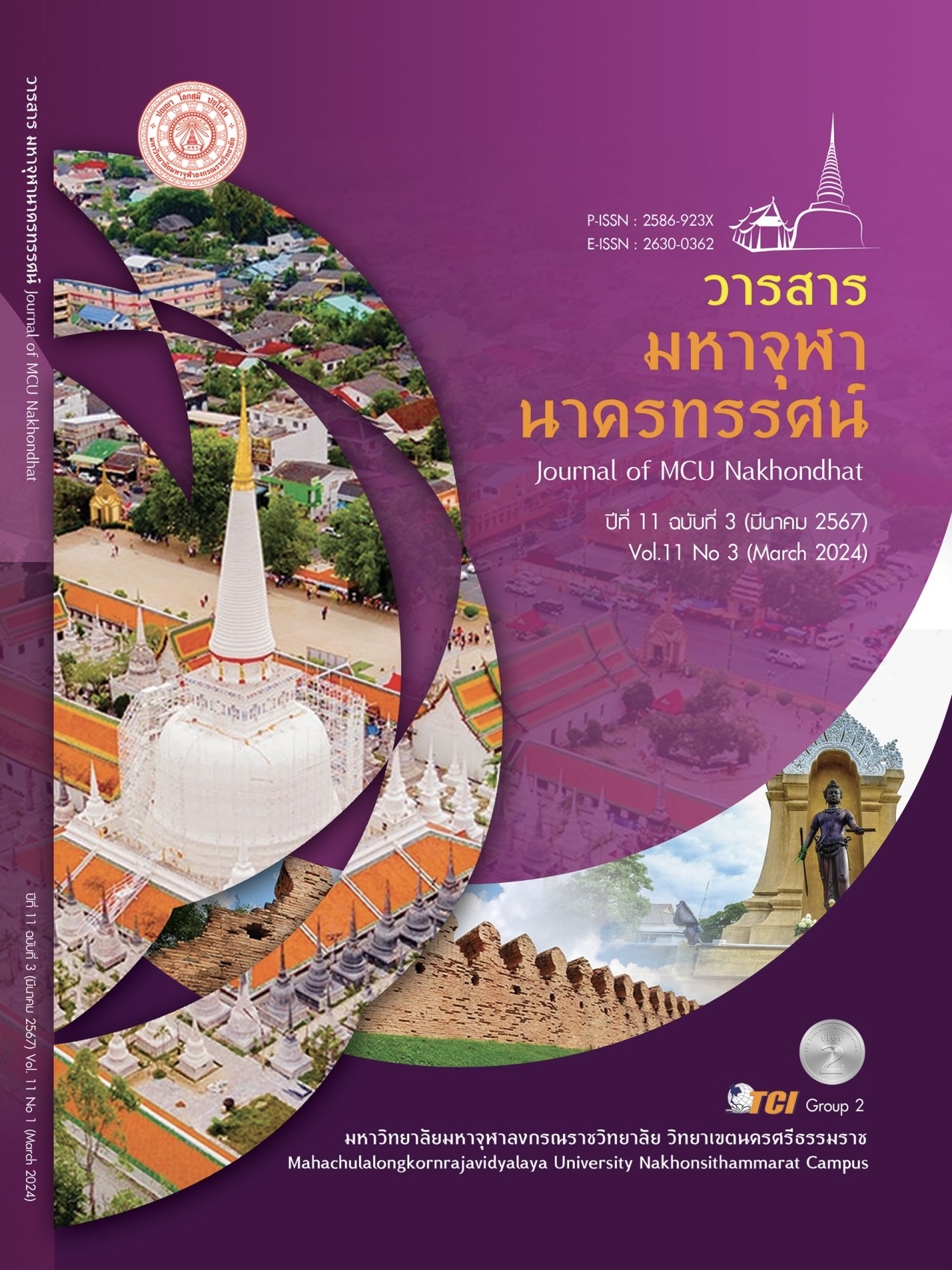รูปแบบการบริหารจัดการ “SAWANG MODEL” ด้วยวงจรคุณภาพ PDCA สู่ความเป็นโรงเรียนคุณธรรม สพฐ. : ถอดบทเรียนโรงเรียนวัดสว่างอารมณ์ สำนักงานเขตพื้นที่การศึกษาประถมศึกษาพระนครศรีอยุธยา เขต 1
Main Article Content
บทคัดย่อ
บทความวิจัยนี้มีวัตถุประสงค์ เพื่อนำเสนอรูปแบบการบริหารจัดการ “SAWANG MODEL” ด้วยวงจรคุณภาพ PDCA สู่ความเป็นโรงเรียนคุณธรรม สพฐ. : ถอดบทเรียนโรงเรียนวัดสว่างอารมณ์ สำนักงานเขตพื้นที่การศึกษาประถมศึกษาพระนครศรีอยุธยา เขต 1 โดยโรงเรียนวัดสว่างอารมณ์ได้เข้าร่วมเป็นโรงเรียนคุณธรรม สพฐ. ได้จัดกิจกรรมการเรียนการสอนที่สอดแทรกคุณธรรม จริยธรรม ผลการศึกษา พบว่า โรงเรียนวัดสว่างอารมณ์ได้จัดทำโครงการในการพัฒนาคุณธรรมจริยธรรมนักเรียน เพื่อให้การดำเนินงานประสบความสำเร็จตามวัตถุประสงค์ที่วางไว้ ผู้บริหารโรงเรียนวัดสว่างอารมณ์ มีแนวคิดในการพัฒนารูปแบบการบริหารจัดการ “SAWANG MODEL” ด้วยวงจรคุณภาพ PDCA สู่ความเป็นโรงเรียนคุณธรรม สพฐ. ซึ่งเป็นนวัตกรรมที่พัฒนาขึ้นเพื่อเป็นเครื่องมือในการบริหารจัดการขับเคลื่อนการดำเนินงาน โรงเรียนคุณธรรม สพฐ. เพื่อการเสริมสร้าง พัฒนา และปลูกฝังคุณธรรม จริยธรรมให้กับผู้เรียนให้เป็นผู้มีคูณธรรมนำความรู้ เพื่อพัฒนาสังคมและประเทศชาติ นอกจากนี้ พบว่า โรงเรียนวัดสว่างอารมณ์ได้ประยุกต์ใช้หลักธรรมทางพระพุทธศาสนา คือ หลักภาวนา 4 ในการบริหารจัดการ ประกอบด้วย 1) กายภาวนา คือ การเจริญกาย การพัฒนากาย การฝึกอบรมกาย ให้รู้จักติดต่อเกี่ยวข้องกับหุ้นส่วนต่าง ๆ 2) สีลภาวนา คือ การเจริญศีล การพัฒนาความประพฤติ การฝึกอบรมศีล ให้ตั้งอยู่ในระเบียบวินัยขององค์กร ไม่เบียดเบียนหรือก่อความเดือดร้อนเสียหาย อยู่ร่วมกับผู้อื่นได้ด้วยดี และเกิดการเกื้อกูลแก่กันและกัน 3) จิตภาวนา คือ การเจริญจิต การพัฒนาจิต การฝึกอบรมจิตใจ ให้เข้มแข็งมั่นคงเจริญงอกงามด้วยคุณธรรม และ 4) ปัญญาภาวนา คือ การเจริญปัญญา การพัฒนาปัญญา การฝึกอบรมปัญญา ให้รู้เข้าใจสิ่งทั้งหลายตามเป็นจริง ซึ่งส่งผลให้ผู้เรียนมีคุณธรรมตามคุณธรรมเป้าหมายของโรงเรียนวัดสว่างอารมณ์ ร้อยละ 91.42 ในระดับดีขึ้นไป สูงกว่าเป้าหมายที่ตั้งไว้
Article Details

อนุญาตภายใต้เงื่อนไข Creative Commons Attribution-NonCommercial-NoDerivatives 4.0 International License.
เอกสารอ้างอิง
กระทรวงศึกษาธิการ. (2551). หลักสูตรแกนกลางศึกษาขั้นพื้นฐาน พุทธศักราช 2551. กรุงเทพมหานคร: โรงพิมพ์ชุมนุมสหกรณ์การเกษตรแห่งประเทศไทย จำกัด.
ประกาศเรื่อง ยุทธศาสตร์ชาติ. (2561). ราชกิจจานุเบกษา. เล่ม 135 ตอนที่ 82 ก หน้า 5 (13 ตุลาคม 2561).
โรงเรียนวัดสว่างอารมณ์. (2565). รายงานผลการประเมินตนเองของสถานศึกษา (Self-Assessment Report: SAR). พระนครศรีอยุธยา: โรงเรียนวัดสว่างอารมณ์.
โรงเรียนวัดสว่างอารมณ์. (2566). รายงานรูปแบบบริหารจัดการ "SAWANG MODEL ด้วยวงจรคุณภาพ PDCA สู่ความเป็นโรงเรียนคุณธรรม สพฐ.". พระนครศรีอยุธยา: โรงเรียนวัดสว่างอารมณ์.
วิฑูรย์ สิมะโชคดี. (2545). คุณภาพ คือ การบูรณาการ. กรุงเทพมหานคร: สมาคมส่งเสริมเทคโนโลยี.
สำนักงานคณะกรรมการการศึกษาแห่งชาติ. (2545). แนวทางการประกันคุณภาพภายในสถานศึกษา: เพื่อพร้อมรับการประเมินภายนอก. (พิมพ์ครั้งที่ 4). กรุงเทพมหานคร: บริษัทพิมพ์ดี จำกัด.
สำนักงานจังหวัดพระนครศรีอยุธยา. (2566). แผนพัฒนาจังหวัดพระนครศรีอยุธยา (พ.ศ. 2566 - 2570). พระนครศรีอยุธยา: สำนักงานจังหวัดพระนครศรีอยุธยา.
สำนักพัฒนานวัตกรรมการจัดการศึกษา. (2559). แนวทางการขับเคลื่อนโครงการโรงเรียนคุณธรรม สพฐ.ประจำปีงบประมาณ พ.ศ.2560. กรุงเทพมหานคร: สำนักพัฒนานวัตกรรมการจัดการศึกษา.
สำนักพัฒนานวัตกรรมการจัดการศึกษา. (2560). โรงเรียนคุณธรรม สพฐ.มาตรฐานและตัวชี้วัด. เรียกใช้เมื่อ 6 ธันวาคม 2566 จาก http://ita.rayong2.go.th/wp-content/uploads/2019/07/moral-school-11.pdf
สุธาสินี โพธิจันทร์. (2558). PDCA หัวใจสำคัญของการปรับปรุงอย่างต่อเนื่อง. เรียกใช้เมื่อ 5 มกราคม 2567 จาก https://www.ftpi.or.th/2015/2125.


